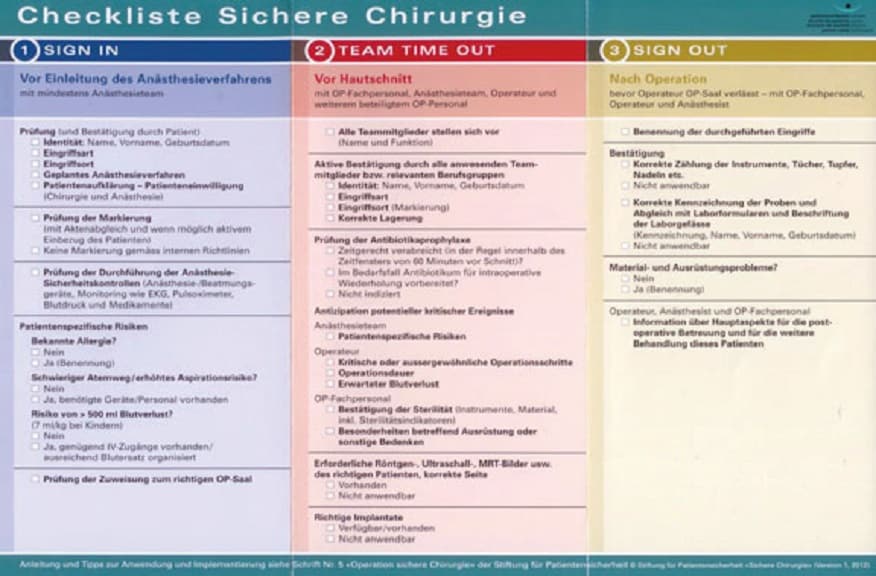Patient safety above all
The quality of service providers in the Swiss healthcare system has always been considered undisputedly high. Nevertheless, interest in quality issues has grown strongly among the public and politicians in recent years. With the introduction of flat rates per case in 2012, the need to measure and compare the quality of treatment outcomes has increased further.

Dhe Swiss hospitals and clinics provide high-quality work. Quality management in the healthcare sector and quality assurance are becoming increasingly important in the increasingly competitive healthcare market. The various players in the healthcare system and the hospitals and clinics have different ideas about what is meant by the term quality. Thus, the legal framework in which the hospital operates also plays a central role in relation to the development of a quality-promoting environment.
Increased transparency required
According to the Health Insurance Act (KVG), hospitals and clinics are mandated to ensure and promote their quality in a targeted and systematic manner. With the entry into force of the federal law of 2007, hospitals and clinics are required to report on the efficiency and quality of their services. The introduction of flat rates per case increases transparency in the healthcare system. Patients can better compare the services of individual hospitals and clinics for elective procedures and then decide where they want to be treated. This creates new conditions for quality competition.
Transparency and comparability of data
Quality reporting and the publication of measurement results and quality indicators are closely related to transparency. But transparency must be handled with care. Reactions from the media and politicians give cause for concern that increased transparency unsettles the public and carries the risk of abusive interpretations. For hospitals and clinics, there is also a growing fear of unfounded sanctions or legal disputes.
Mortality rates, for example, are not quality indicators per se, although they serve the purpose of continuous quality improvement. However, mortality rates do not say anything about the quality of the services provided in relation to an individual facility and cannot be compared with each other. The FOPH publishes mortality figures and takes into account the age and sex of patients, thus achieving a certain risk adjustment, but does not distinguish between deaths due to illness and accidents and avoidable deaths due to errors. For this reason, the public publication of mortality figures for selected treatments and the use of these mortality rates as a quality indicator are misleading, since mortality can vary depending on the hospital and patient mix and a direct comparison between hospitals and clinics is therefore not permissible. A high mortality rate for a particular treatment does not necessarily indicate poor quality of treatment. The results of the mortality statistics must therefore be interpreted in a differentiated manner and with the necessary caution.
The role of H+
As a representative of the interests of hospitals and clinics, H+ also sees itself as part of a network when it comes to quality issues (see box). H+ is committed to the disclosure of reliable quality of outcomes. Within the National Association for Quality Development in Hospitals and Clinics (ANQ), hospitals, insurers and cantons agreed on a measurement plan for the inpatient areas in acute somatic medicine, rehabilitation and psychiatry. Uniformly used measurement instruments make it possible to make quality comparisons. H+ has six representatives on the ANQ Board and coordinates the consultation of the evaluation and publication concepts with the members.
In addition, H+ supports its members with the industry solution Quality and offers an annual template for quality reporting. More than 220 hospitals and clinics now publish their quality reports on the hospital portal www.spitalinformation.ch, which is managed by H+.
With the hospital portal www.spitalinformation.ch, H+ contributes to more transparency in the hospital and clinic sector. The portal includes search functions for acute care, psychiatry, rehabilitation and emergency wards (Fig. 1). The website is a valuable aid for patients and referrers in their search for a hospital. Thanks to spitalinformation.ch, patients can find the right hospital quickly and easily, tailored to their own needs. The website is supplemented by the free "Spitalinformation" mobile app for smartphones. Thanks to this solution, you can also look up where the nearest hospital with an emergency ward is located while on the move. Tips on how to react correctly in an emergency situation are also provided.
No paper jungle, but added value for the patient
In addition to providing support within national quality assurance efforts, H+ also advocates for the entrepreneurial freedom of its members. This is because hospitals and clinics strive for high quality in their own interests, including in the areas of hygiene and medication safety. They check this regularly, e.g. in the form of audits or certifications.
With a focus on patient safety, H+ supports the vote "as many specifications as necessary, as few as possible". A flood of information and unnecessary documentation should be avoided. Duplications must be combated. In health care, the primary quality characteristics - treatment success and safety - are often difficult to measure or can only be measured with great effort. The goal of an efficient quality management system is to limit documentation to what is necessary and to create the basis for improvement measures in order to ultimately generate patient benefits.
Patient safety as an important component of quality assurance
Mistakes happen everywhere where people work - including in medicine. In surgery, for example, surgical errors such as side or procedure mix-ups, infections or forgotten foreign bodies are taboo, but can also occur in Switzerland. The key to improvement lies not in appeals to care and apportioning blame, but in developing a consistent and constructive safety culture. The Swiss Patient Safety Foundation offers assistance in the introduction and implementation of safety concepts. It is currently coordinating a pilot program that is intended to contribute to better safety management in surgery. The core element is the WHO checklist, which has been adapted for Switzerland (Fig. 2). The systematic use of a surgical checklist can prevent incidents or catch them in time. Another national project in the field of medication safety will follow.
Quality of Swiss hospitals in international comparison
The quality of the services provided by the Swiss healthcare system is undisputedly high compared with OECD countries. This is reflected in traditional indicators of the health status of the population, such as the above-average life expectancy at birth, but also in the scope and accessibility of services, access to medicines and patients' rights and information.
In the inpatient sector, the ANQ already enables initial statements to be made. The results of the prevalence measurement of falls and pressure ulcers (bedsores) show that Swiss hospitals and clinics are very good internationally in the prevention of pressure ulcers. In direct comparison with measurements in other countries, Swiss pressure ulcer rates (with and without category 1) are gratifyingly low.
Hospital physicians, nursing staff and all other professional groups in hospitals and clinics work closely together in partnership to provide the best possible treatment for patients. Quality assurance ultimately affects everyone who works with patients.









